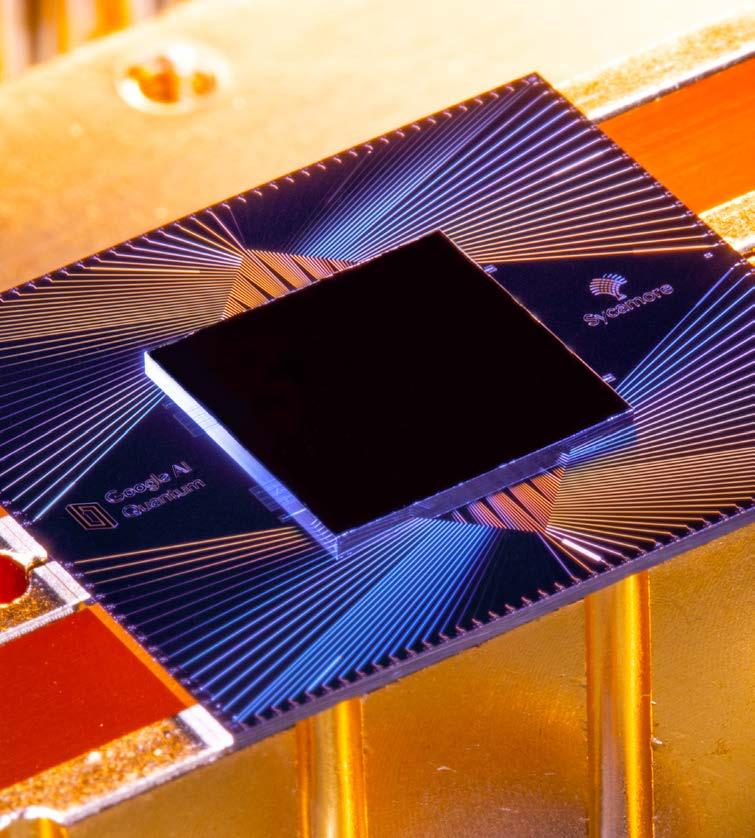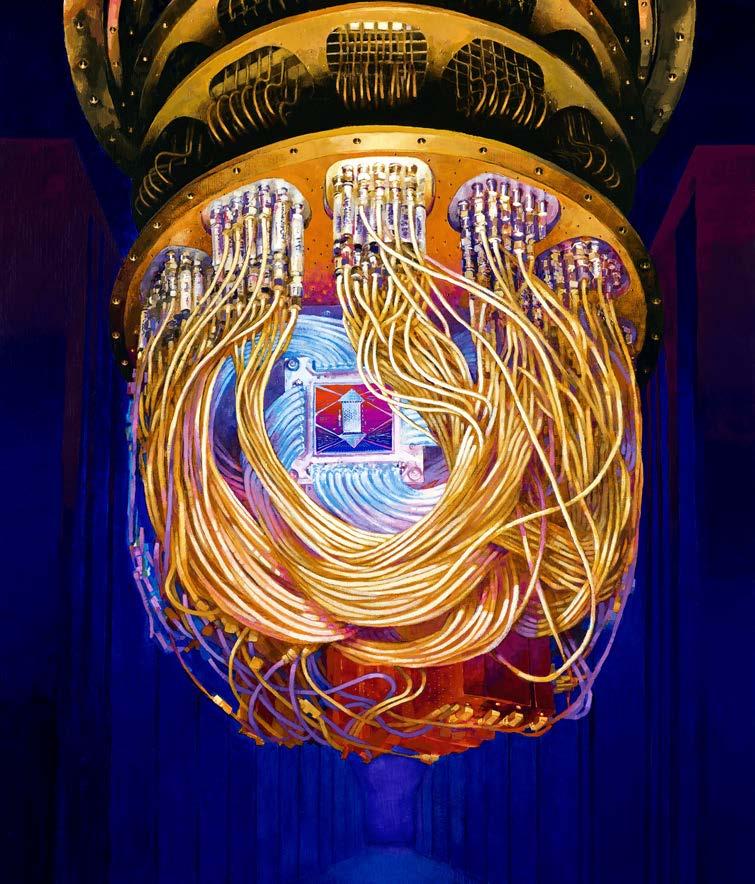
7 minute read
Sycamore” Breaks the Speed Limit UCSB physicist John Martinis leads the Goleta-based Google team that achieved quantum supremacy
QA & Faculty JOHN MARTINIS
“Sycamore” Breaks the Speed Limit “Sycamore” Breaks the Speed Limit “Sycamore” Breaks the Speed Limit
Advertisement
UCSB physicist John Martinis leads the Goleta-based Google team that achieved quantum supremacy
Last fall, a paper in the journal Nature described how Google’s 53-qubit quantum computer, named “Sycamore,” had achieved “quantum supremacy” by solving a massive sorting problem in a couple of minutes that Google said would have taken ten thousand years to solve on the world’s most powerful supercomputer.
IBM, which built that supercomputer, named “Summit,” balked at the claim, arguing that certain data-packaging strategies would have enabled its sprawling machine to solve the problem in a period closer to two and a half days than to ten thousand years.
To longtime UCSB physics professor John Martinis, now chief scientist and head of the hardware group that is building Sycamore, which hangs suspended like an elegant,

With its number-crunching capacity enabled by 53 qubits, like the one shown (top), “Sycamore” (above) provided a powerful proof of the quantum-computing concept.
copper-wire-clad chandelier in an industrial park near UCSB, the debate is moot. The point, to him, is that Sycamore is faster, a lot faster; exactly how much faster is not so important, because the speed advantage will grow exponentially as new qubits are added. If another 53-qubit chip (actually, it has 54-qubits, but one failed during the test) were added to Sycamore, Martinis suggests, a digital supercomputer would need to be the size of a city to compete.
Regardless of one’s take on the test, it was perhaps the
most exciting moment in quantum computing to date, making this a good time to catch up with Martinis. Convergence spoke with him at Google’s Goleta lab in February.
Convergence: So, where are you in the development of this machine? John Martinis: The fi fty-three-qubit Sycamore device is a functioning quantum computer, and we actually have a practical application for it. But if you want a quantum computer that can solve practical problems that you can’t solve with a supercomputer and do it without errors, you’ll need something like a hundred thousand to a million qubits. That’s kind of how we’re thinking about it in the long term. So, we’re just going to make this thing bigger and bigger. There is a lot of overhead associated with error correction, which makes it hard.
C: You ran the quantum-supremacy test with 53 qubits on a 54-qubit chip. What happened to the 54th? JM: The qubit was good, but there was a partial short on one of the wirings on the mount circuit board. We knew that the fault existed when we cooled it down a year ago. [The qubits have to be cooled to barely above absolute zero for quantum computing to occur.] But it was our fi rst chip, and we thought, It’s only one qubit, and it’s off to the side, so if it doesn’t work, it doesn’t matter anyway because there’s going to be something else we have to fi x. When you do something for the fi rst time, nothing ever works perfectly. It was amazing that basically everything else worked, and we could do the experiment. That was not expected, and it was great.
C: On your way to one hundred thousand, or a million, qubits, when do you make the next incremental increase? JM: We’re working to make the chips better, so they have fewer errors. We want to reduce the errors by a factor of about fi ve. That’s good enough to do error correction, and then we have to scale up.
C: If and when quantum computers become part of the “regular” computing landscape, how do you think they will be accessed and used? JM: We think the natural way to use the quantum computer we have now and will have in the future is to have cloud access, which is essentially how supercomputers are used now. No one sits next to one and types in their program; they access it on the internet. Your laptop and your cellphone — they’re both just interface devices, because most of the computation is done in the cloud these days. So, going to that kind of a model is perfectly sensible. This is really hard to build, and it may never be small and portable like a classical computer, but on the other hand, when classical computing started, no one believed that we could build it at the sizes we do now.
C: Do you foresee any materials solutions to quantum-computing challenges, and are you working with anyone at the new NSF–funded UC Santa Barbara Quantum Foundry? JM: It’s fundamentally impossible to make a perfect qubit. Nature is working against you, and you’re always going to have errors. Classical information can be fundamentally stable, but quantum computing is fundamentally unstable, because quantum systems are by their nature, environmentally sensitive and therefore inherently unstable. There are a lot of open questions in materials that we need to understand, and we communicate that to people we’re working
with, both at the university — and some of them are affi liated with the new foundry — and at other outside entities. At this point, though, a lot of the work we’re doing is a bit proprietary.
C: How did you come to your position with Google? JM: I’ve been working on quantum computing since the mid-1980s. Six years ago, we had got far enough along with our research at UCSB that Google took note and started thinking about having a hardware effort.
I wanted to build a quantum computer, our UCSB team wanted to build one, and Google wanted to build one. Our desires kind of lined up, and it was the right time. We had just got some results and wanted to do something more security encryption, which is based on the fact that it’s easy to take prime numbers and multiply them and the resulting number is very hard, exponentially hard, to factor. The current thinking is that if you can make fast, high-quality qubits — and we don’t know if that can be done — you would need twenty million to fi fty million physical qubits to do the RSA hacking.
People who worry about and work on security know that RSA is not quantum-safe, but they know that there are other algorithms that are quantum-safe. They’re working on it. There’s a program at NIST [the National Institute of Standards and Technology] to come up with something to replace RSA. The world has a decent amount of time — probably twenty years — before it has to worry about a quantum

complicated and keep the team together, and that’s hard to do at a university. Building a machine seemed a little more industrial, so moving from academia to an industrial setting seemed the right thing to do.
Working with industry, you don’t have issues with government funding. The engineering and physics challenges are so hard that, at the university, you bring people in as PhD students and you train them up, and then they leave. This way, we’re focused on the work, we have all the funding, our researchers can start families and buy homes, and I can focus all my effort on building this thing instead of continuously raising money.
What was very nice was how well UCSB and the Offi ce of Research worked with Google to come up with an arrangement that makes sense. There’s a lot of benefi t for everyone, and I really thank UCSB for being understanding of the situation and working hard to make it work. computer. Every security and cryptosystem ever built has a fi nite lifetime, because new technology comes around and people fi gure it out, so to expect RSA to last forever is silly. It’s not something we think too much about, because we believe that our value is added in other things and not that. ” I wanted to build a quantum computer, our UCSB team wanted to build one, and Google wanted to build one. Our desires lined up, and it was the right time. “
C: What are your thoughts on the security concerns related to quantum computers, i.e. that they will be able to hack into systems in seconds, and is that something you concern yourself with at this point? JM: People use RSA [Rivest-Shamir-Adleman] algorithms for
Photograph by Eric Lucero










